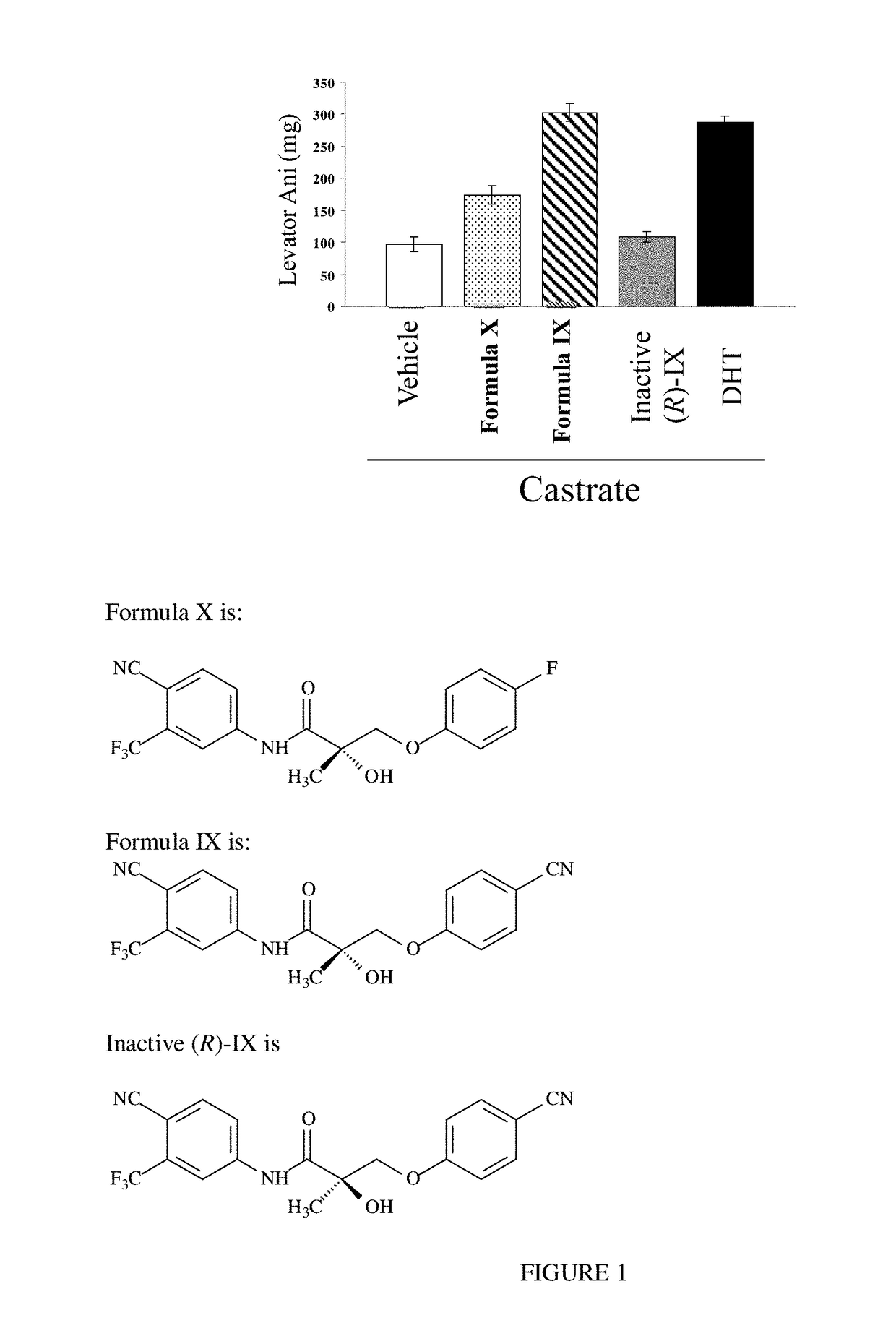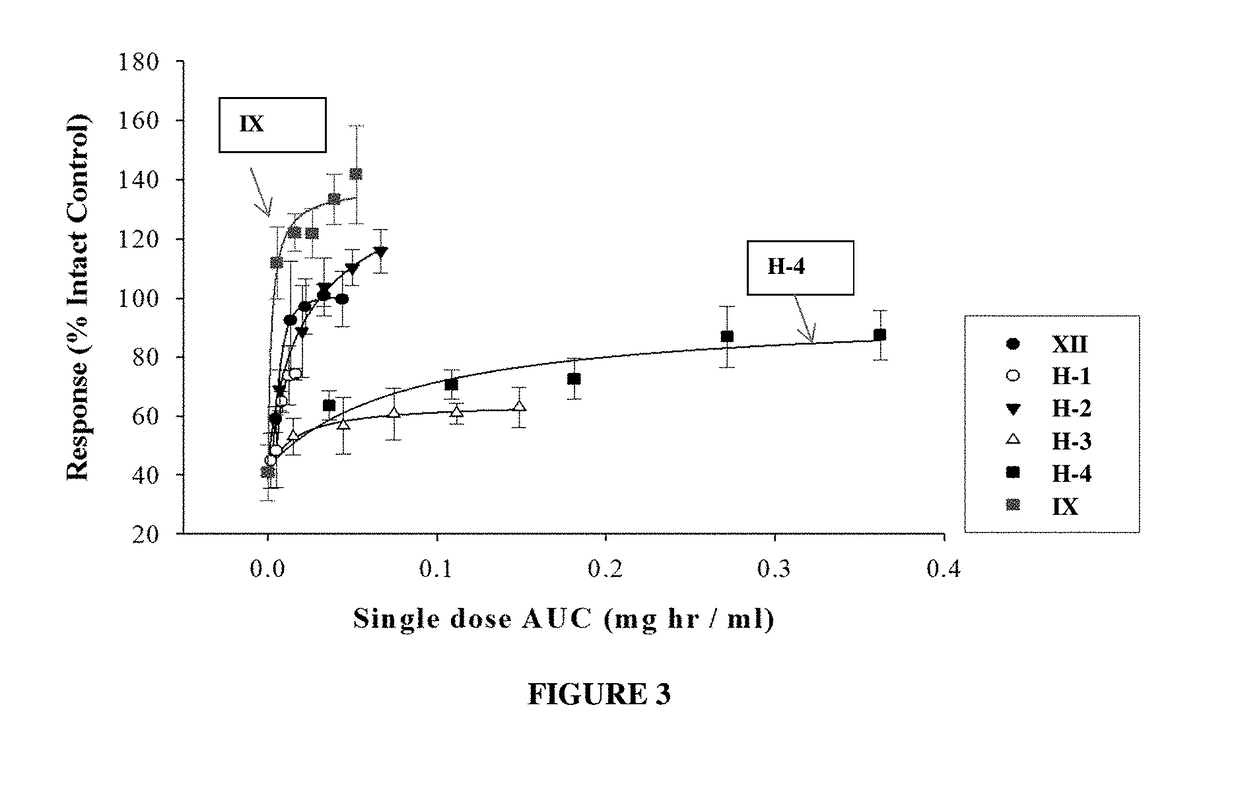METHODS OF TREATING UROLOGICAL DISORDERS USING SARMs
a technology of urological disorders and sarms, which is applied in the direction of nitrile/isonitrile active ingredients, medical preparations, organic active ingredients, etc., can solve the problems of incontinence and pelvic floor disorders, decreased ability to regulate the urethra, and weak sphincter
- Summary
- Abstract
- Description
- Claims
- Application Information
AI Technical Summary
Benefits of technology
Problems solved by technology
Method used
Image
Examples
example 1
Use of SARMs for Increase Muscles of the Pelvic Floor
[0255]As discussed above, weakening and / or atrophy of the levator ani can lead to instability of the pelvic floor and inability to maintain urethral closure during transiently elevated intraabdominal pressure, resulting in stress urinary incontinence. The levator ani muscle, and other muscles of the pelvic floor such as the urethral sphincter, are exquisitely sensitive to the anabolic actions of androgens [Hershberger et al., Myotrophic activity of such as testosterone and other steroids as determined by modified levator ani muscle method. [Proc. Soc. Exp. Biol. Med. (1953) 83: 175-180; Ho et al., Anabolic effects of androgens on muscles of female pelvic floor and lower urinary tract. Curr. Opin. Obstet. Gynecol. (2004) 16: 405-409].
[0256]Treatment with DHT or Formula X and Formula IX in vivo elicits hypertrophy of the levator ani muscle as presented in FIG. 1. Sprague Dawley rats (n=5; 200 g weight) that were castrated and treate...
example 2
Non-Steroidal Tissue-Selective Androgen Receptor Modulators (SARMs) Improve Pelvic Floor Muscle Mass and Architecture in Female Ovariectomized Mice
[0258]The androgen receptor (AR) is a ligand-activated transcription factor that is critical for the growth and development of muscle, bone, endocrine and reproductive organs. In the absence of ligand (i.e., endogenous androgens), the AR is maintained in an inactive complex through its interactions with heat shock proteins (HSPs) and corepressors. Upon ligand (e.g., testosterone or dihydrotestosterone) binding, the HSPs dissociate from the AR, leading to a change in its conformation and the subsequent dimerization and nuclear localization of the AR. The AR dimer binds to hormone response elements (HRE) on the promoter of hormone responsive gene, recruits various coactivators and general transcription factors, and induces the transcription of the target gene. Although many tissues have cells that possess ARs and are considered to be androg...
example 3
Compound of Formula IX as a Treatment for Stress Urinary Incontinence (SUI), Urge Urinary Incontinence (UUI), and Mixed Incontinence in Post-Menopausal Women
A Proof of Concept Clinical Study
[0290]This was initially a single site, proof of concept feasibility study to describe the effect of the S-isomer of the compound of Formula IX (Compound IX) 3 mg in postmenopausal female subjects with SUI. However, data presented herein were from subjects seen at 3 separate sites.
[0291]Primary Objective:
[0292]Described is the effect of 12 weeks of treatment of Compound IX on the number of stress urinary incontinence episodes / day as assessed by the 3 day voiding diary. See leaks / day data in Tables 2 (individual subject data from all 3 sites), Tables 4-6 (mean stress leaks for sites 1, 2, and 3, respectively), and FIG. 10 (mean stress leaks / day across all sites). Further, see Table 3 for the durability of this response in subjects assessed at 16, 24, 32 and 40 weeks (and their pad weights). The fi...
PUM
| Property | Measurement | Unit |
|---|---|---|
| Time | aaaaa | aaaaa |
| Time | aaaaa | aaaaa |
| Mass | aaaaa | aaaaa |
Abstract
Description
Claims
Application Information
 Login to View More
Login to View More - R&D
- Intellectual Property
- Life Sciences
- Materials
- Tech Scout
- Unparalleled Data Quality
- Higher Quality Content
- 60% Fewer Hallucinations
Browse by: Latest US Patents, China's latest patents, Technical Efficacy Thesaurus, Application Domain, Technology Topic, Popular Technical Reports.
© 2025 PatSnap. All rights reserved.Legal|Privacy policy|Modern Slavery Act Transparency Statement|Sitemap|About US| Contact US: help@patsnap.com



